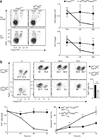Id2 and Id3 maintain the regulatory T cell pool to suppress inflammatory disease
- PMID: 24973820
- PMCID: PMC4365819
- DOI: 10.1038/ni.2928
Id2 and Id3 maintain the regulatory T cell pool to suppress inflammatory disease
Abstract
Regulatory T (Treg) cells suppress the development of inflammatory disease, but our knowledge of transcriptional regulators that control this function remains incomplete. Here we show that expression of Id2 and Id3 in Treg cells was required to suppress development of fatal inflammatory disease. We found that T cell antigen receptor (TCR)-driven signaling initially decreased the abundance of Id3, which led to the activation of a follicular regulatory T (TFR) cell-specific transcription signature. However, sustained lower abundance of Id2 and Id3 interfered with proper development of TFR cells. Depletion of Id2 and Id3 expression in Treg cells resulted in compromised maintenance and localization of the Treg cell population. Thus, Id2 and Id3 enforce TFR cell checkpoints and control the maintenance and homing of Treg cells.
Figures








Similar articles
-
Transcription factor ID2 prevents E proteins from enforcing a naïve T lymphocyte gene program during NK cell development.Sci Immunol. 2018 Apr 27;3(22):eaao2139. doi: 10.1126/sciimmunol.aao2139. Sci Immunol. 2018. PMID: 29703840 Free PMC article.
-
ID2 and ID3 are indispensable for Th1 cell differentiation during influenza virus infection in mice.Eur J Immunol. 2019 Mar;49(3):476-489. doi: 10.1002/eji.201847822. Epub 2019 Jan 4. Eur J Immunol. 2019. PMID: 30578645
-
The Transcriptional Regulator Id2 Is Critical for Adipose-Resident Regulatory T Cell Differentiation, Survival, and Function.J Immunol. 2019 Aug 1;203(3):658-664. doi: 10.4049/jimmunol.1900358. Epub 2019 Jun 14. J Immunol. 2019. PMID: 31201238 Free PMC article.
-
Shifting gears: Id3 enables recruitment of E proteins to new targets during T cell development and differentiation.Front Immunol. 2022 Aug 2;13:956156. doi: 10.3389/fimmu.2022.956156. eCollection 2022. Front Immunol. 2022. PMID: 35983064 Free PMC article. Review.
-
Regulatory T cells: roles of T cell receptor for their development and function.Semin Immunopathol. 2010 Jun;32(2):95-106. doi: 10.1007/s00281-010-0200-5. Epub 2010 Feb 24. Semin Immunopathol. 2010. PMID: 20179931 Review.
Cited by
-
T follicular regulatory cells: Guardians of the germinal centre?Scand J Immunol. 2020 Oct;92(4):e12942. doi: 10.1111/sji.12942. Scand J Immunol. 2020. PMID: 32697349 Free PMC article. Review.
-
Long noncoding RNA expression profiles in gut tissues constitute molecular signatures that reflect the types of microbes.Sci Rep. 2015 Jun 30;5:11763. doi: 10.1038/srep11763. Sci Rep. 2015. PMID: 26123364 Free PMC article.
-
Transcriptional Regulation of Differentiation and Functions of Effector T Regulatory Cells.Cells. 2019 Aug 20;8(8):939. doi: 10.3390/cells8080939. Cells. 2019. PMID: 31434282 Free PMC article. Review.
-
Transcription factor ID2 prevents E proteins from enforcing a naïve T lymphocyte gene program during NK cell development.Sci Immunol. 2018 Apr 27;3(22):eaao2139. doi: 10.1126/sciimmunol.aao2139. Sci Immunol. 2018. PMID: 29703840 Free PMC article.
-
Integrin Activation Controls Regulatory T Cell-Mediated Peripheral Tolerance.J Immunol. 2018 Jun 15;200(12):4012-4023. doi: 10.4049/jimmunol.1800112. Epub 2018 Apr 27. J Immunol. 2018. PMID: 29703862 Free PMC article.
References
Publication types
MeSH terms
Substances
Associated data
- Actions
Grants and funding
- AI70535/AI/NIAID NIH HHS/United States
- R37 AI038425/AI/NIAID NIH HHS/United States
- U19 AI070535/AI/NIAID NIH HHS/United States
- R01 AI108651/AI/NIAID NIH HHS/United States
- CA054198/CA/NCI NIH HHS/United States
- 1P01AI102853/AI/NIAID NIH HHS/United States
- R37 CA054198/CA/NCI NIH HHS/United States
- R01 AI038425/AI/NIAID NIH HHS/United States
- P01 AI102853/AI/NIAID NIH HHS/United States
- AI 38425/AI/NIAID NIH HHS/United States
- R01 CA054198/CA/NCI NIH HHS/United States
- R01 CA078384/CA/NCI NIH HHS/United States
- AI 7211/AI/NIAID NIH HHS/United States
- CA78384/CA/NCI NIH HHS/United States
LinkOut - more resources
Full Text Sources
Other Literature Sources
Molecular Biology Databases

